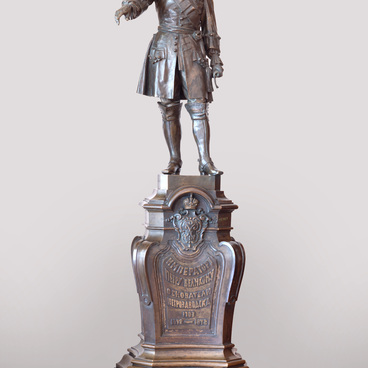The “Madonna” from the Alexander Palace is an imitation of a work by the Italian Renaissance painter Pietro Vanucci (Perugino). The image is taken from a triptych by the master created for a monastery in Certosa di Pavia in Italy. The work was executed in the style of fourteenth-century Italian painting: it has a shaped board and the image is applied to a gold background with an “embossed” primer around the perimeter. This image depicting Madonna adorned the bedroom of Empress Alexandra Feodorovna.
Along with traditional orthodox icons, on the north wall of the room, there was a series of copies reproducing works of outstanding Italian Renaissance masters with the most famous images of Madonna and Christ Child.
Only a few details of Perugino’s childhood and adolescence have come down to this day. It is known that he was born into a poor family. In 1470, the painter arrived in Florence to take drawing lessons from Francesco di Bonifaci and Fiorenzo di Lorenzo. A few years later he opened his own studio. One of Pietro Perugino’s earliest surviving works is the fresco Saint Sebastian, painted for the Church of Santa Maria in Cerqueto. The painter’s first works had already received rave reviews and his fame quickly spread beyond Florence’s borders.
The heyday of the artist’s work came in the last decades of the fifteenth century. Together with other Florentine artists, Pietro worked on the decoration of the Sistine Chapel. In the original version, the entire wall of the chapel was decorated solely with works by Perugino. Working on the frescoes, the artist created his own method of depicting his images, characterized by tranquility and harmony.
At the end of the 19th century, a group of young Italian artists began to produce easel works imitating the works of Italian Renaissance masters. Replicas of the most outstanding works of religious painting and majolica of the 14th — 16th centuries were very popular among both connoisseurs of European art and ordinary citizens of the turn of the 20th century.
Along with traditional orthodox icons, on the north wall of the room, there was a series of copies reproducing works of outstanding Italian Renaissance masters with the most famous images of Madonna and Christ Child.
Only a few details of Perugino’s childhood and adolescence have come down to this day. It is known that he was born into a poor family. In 1470, the painter arrived in Florence to take drawing lessons from Francesco di Bonifaci and Fiorenzo di Lorenzo. A few years later he opened his own studio. One of Pietro Perugino’s earliest surviving works is the fresco Saint Sebastian, painted for the Church of Santa Maria in Cerqueto. The painter’s first works had already received rave reviews and his fame quickly spread beyond Florence’s borders.
The heyday of the artist’s work came in the last decades of the fifteenth century. Together with other Florentine artists, Pietro worked on the decoration of the Sistine Chapel. In the original version, the entire wall of the chapel was decorated solely with works by Perugino. Working on the frescoes, the artist created his own method of depicting his images, characterized by tranquility and harmony.
At the end of the 19th century, a group of young Italian artists began to produce easel works imitating the works of Italian Renaissance masters. Replicas of the most outstanding works of religious painting and majolica of the 14th — 16th centuries were very popular among both connoisseurs of European art and ordinary citizens of the turn of the 20th century.



